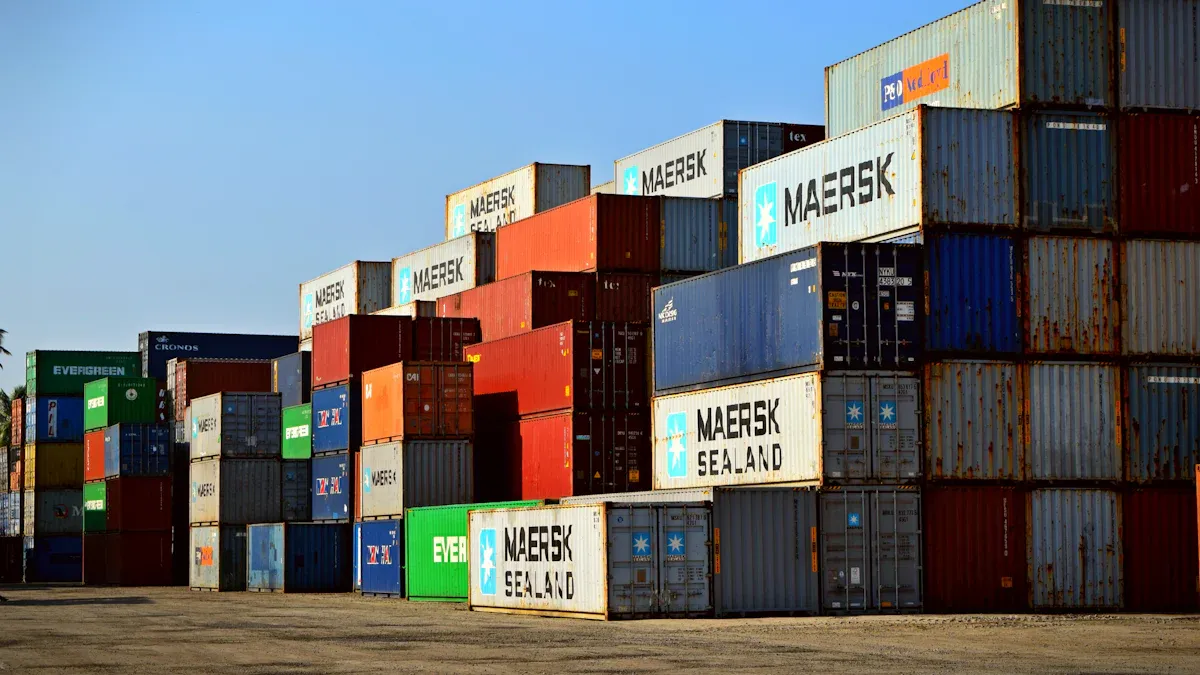
O gerenciamento da cadeia de suprimentos desempenha um papel crucial no sucesso das marcas de beleza. Uma cadeia de suprimentos bem estruturada garante que os produtos atinjam os consumidores com eficiência, mantendo a qualidade e a relação custo-benefício. No entanto, Marcas de beleza enfrentam desafios significativos, como tensões geopolíticas que aumentam custos e interrupções sazonais que afetam a disponibilidade de ingredientes. A crescente demanda do consumidor por fornecimento ético adiciona pressão para adotar práticas de sustentabilidade. Além disso, A integração de tecnologias como o blockchain melhora a transparência, o que é vital para rastrear as origens do produto e construir confiança. Abordando esses fatores, Você pode aprimorar a confiabilidade e a reputação da sua marca em um mercado competitivo.
Principais desafios no gerenciamento da cadeia de suprimentos de beleza
Escassez de matéria -prima e volatilidade dos preços
A escassez de matérias -primas criam obstáculos significativos para marcas de beleza. Essas escassez interrompem a formulação do produto, Atraso no tempo de produção, e aumentar os custos. Por exemplo:
Os custos de frete têm subiu quase dez vezes ano a ano, Tornando o transporte mais caro.
Incertezas comerciais forçam os líderes da cadeia de suprimentos a priorizar a resiliência em vez de eficiência.
A volatilidade dos preços complica ainda mais as questões. Quando os preços das matérias -primas flutuam, As marcas enfrentam desafios para manter preços consistentes para seus produtos. Essa inconsistência pode afetar a confiança e a lealdade do consumidor. Para navegar nesses desafios da cadeia de suprimentos, Você deve adotar estratégias que equilibram o gerenciamento de custos com garantia de qualidade.
Flutuações de demanda e tendências sazonais
A indústria da beleza experimenta frequente flutuações de demanda impulsionadas por tendências sazonais e preferências do consumidor. Por exemplo, Férias e ocasiões especiais geralmente levam a picos na demanda por produtos específicos. Sem gerenciamento de inventário adequado, As marcas correm o risco de ações durante esses períodos de pico.
Tecnologias de automação como automação de processos robóticos (RPA) pode ajudá -lo a monitorar os níveis de inventário em tempo real. Adicionalmente, As ferramentas movidas a IA analisam dados históricos para otimizar a logística de remessa, Garantir a entrega oportuna durante as temporadas de alta demanda. A adaptação de estratégias de marketing para se alinhar com as tendências sazonais também permite que você atenda à mudança de necessidades do consumidor de maneira eficaz.
Pressões de sustentabilidade e expectativas do consumidor
A sustentabilidade tornou -se um foco crítico para as marcas de beleza. Os consumidores buscam cada vez mais produtos ecológicos, com 67% Procurando ativamente por opções sustentáveis. Consumidores mais jovens, particularmente aqueles que estão abaixo 35, Mostre uma forte disposição de pagar mais por produtos ambientalmente responsáveis. No entanto, A sensibilidade ao preço continua sendo uma barreira para alguns, com 33% de consumidores citando o custo como um impedimento.
Para atender a essas expectativas, Você deve integrar práticas sustentáveis à sua cadeia de suprimentos. Isso inclui o fornecimento de matérias -primas com responsabilidade, Usando embalagens ecológicas, e parceria com fornecedores que compartilham seu compromisso com a sustentabilidade. Comunicar esses esforços de forma transparente pode melhorar a reputação da sua marca e promover a lealdade do consumidor.
Conformidade regulatória e segurança do produto
A conformidade regulatória e a segurança do produto são essenciais para a construção de confiança na indústria da beleza. Você deve garantir que seus produtos atendam aos padrões legais e requisitos de segurança para proteger os consumidores e manter a reputação da sua marca. Negligenciar essas áreas pode levar a sérias conseqüências, incluindo perdas financeiras e credibilidade danificada.
Compreendendo os riscos de não conformidade
Quando surgirem problemas de conformidade, Eles podem atrapalhar suas operações e prejudicar sua marca. Considere esses impactos documentados:
Tipo de evidência | Descrição |
|---|---|
Comportamento do consumidor | 67% de consumidores param de comprar de uma marca depois que um problema de segurança surge. |
Impacto da mídia social | Os erros de conformidade podem se tornar virais, DIFERANTE A REPUTAÇÃO da marca. |
Gerenciamento de crises | Desvia o foco executivo das estratégias de crescimento. |
Efeitos da cadeia de suprimentos | As linhas de produtos paralisadas criam efeitos de ondulação nas cadeias de suprimentos. |
Consumo de recursos | Investigações regulatórias podem consumir recursos internos por meses. |
Estudo de caso | Niko Cosmetics reduziu o tempo do ciclo de aprovação regulatório por 35% e lançou novos produtos sem atrasos de conformidade. |
Esses riscos destacam a importância de medidas proativas para evitar falhas de conformidade. Priorizando a segurança e aderência aos regulamentos, Você pode proteger sua marca com esses desafios.
Etapas para garantir a segurança do produto
Você pode tomar várias medidas para garantir a segurança do produto e a conformidade regulatória:
Realize auditorias regulares de seus fornecedores para verificar as práticas de qualidade e fornecimento de ingredientes.
Invista em pesquisa e desenvolvimento para atender aos padrões em evolução, como mudar para embalagens biodegradáveis ou ingredientes orgânicos.
Implementar sistemas de rastreabilidade para rastrear todas as etapas da produção, garantindo transparência e responsabilidade.
A não conformidade pode levar a recalls de produtos caros, que podem danificar a confiança do varejista e resultar em perdas de seis dígitos. Ficando à frente dos regulamentos, Você pode evitar esses contratempos e se concentrar no crescimento.
Aproveitando a tecnologia para conformidade
A tecnologia desempenha um papel vital na simplificação dos processos de conformidade. Você pode usar ferramentas de software para monitorar alterações regulatórias e automatizar a documentação. A tecnologia blockchain aumenta a transparência, fornecendo um registro imutável de suas atividades da cadeia de suprimentos. Essas inovações reduzem o risco de erros e melhoram a eficiência, permitindo que você se concentre em fornecer produtos de alta qualidade.
Dica: Treinar sua equipe em protocolos de conformidade garante que todos entendam seu papel na manutenção da segurança do produto. Uma equipe bem informada reduz a probabilidade de erros e fortalece sua estratégia geral de conformidade.
Abordando a conformidade regulatória e a segurança do produto, Você não apenas protege seus clientes, mas também posiciona sua marca como um jogador confiável e responsável na indústria da beleza.
Estratégias eficazes para superar os desafios da cadeia de suprimentos
Construindo relacionamentos fortes de fornecedores
Fortes relacionamentos de fornecedores formar a espinha dorsal do gerenciamento eficaz da cadeia de suprimentos. Quando você colabora de perto com seus fornecedores, você ganha melhor visibilidade em suas operações. Isso ajuda a antecipar possíveis interrupções e abordá -las antes de escalar. Os fornecedores geralmente servem como a primeira linha de defesa contra desafios como escassez de matérias -primas ou atrasos. Promovendo confiança e comunicação aberta, Você pode criar uma parceria que beneficie as duas partes.
Benefícios de fortes relacionamentos de fornecedores | Descrição |
|---|---|
Visibilidade aprimorada | Melhor insight sobre operações de fornecedores e riscos potenciais. |
Tempos de entrega reduzidos | Entrega mais rápida de matérias -primas e componentes. |
Identificação de risco precoce | Os fornecedores podem alertá -lo sobre possíveis problemas, Permitir planejamento proativo de contingência. |
Ignorar os relacionamentos de fornecedores pode colocar sua marca em desvantagem. Os fornecedores desempenham um papel crítico para garantir a entrega oportuna e manter a qualidade do produto. Priorizando essas parcerias, Você pode fortalecer sua cadeia de suprimentos e criar resiliência contra desafios imprevistos.
Dica: Programe reuniões regulares com seus fornecedores para discutir o desempenho, expectativas, e as próximas mudanças. Isso garante o alinhamento e promove o crescimento mútuo.
Diversificando fontes de suprimento
Confiar em um único fornecedor ou região para matérias -primas pode expor sua marca a riscos significativos. Tensões geopolíticas, Desastres naturais, ou instabilidade econômica pode atrapalhar sua cadeia de suprimentos. A diversificação de suas fontes de suprimento reduz a dependência e garante um fluxo constante de materiais, mesmo durante as crises.
Por exemplo, O fornecimento de matérias -primas de várias regiões pode protegê -lo da escassez localizada. Também permite que você compare custos e qualidade, garantindo que você obtenha o melhor valor para o seu investimento. A diversificação não apenas mitiga os riscos, mas também aprimora sua capacidade de se adaptar às mudanças nas condições do mercado.
Para implementar esta estratégia de maneira eficaz:
Identifique fornecedores alternativos em diferentes regiões.
Avaliar sua confiabilidade, padrões de qualidade, e preços.
Estabelecer contratos com fornecedores de backup para garantir a continuidade durante as interrupções.
Diversificando suas fontes de suprimento, Você pode proteger suas operações e manter a disponibilidade consistente do produto para seus clientes.
Implementando previsão de demanda e gerenciamento de inventário
Previsão precisa da demanda e gerenciamento eficiente de inventário são essenciais para superar os desafios da cadeia de suprimentos. Quando você entende os padrões de demanda do consumidor, Você pode alinhar seus níveis de produção e inventário de acordo. Isso minimiza o risco de estoques ou excesso de inventário, ambos podem prejudicar seus resultados.
Uma empresa de cosméticos multinacionais uma vez lutou com processos de vendas e operações desalinhados, levando a ações frequentes e altos custos de inventário. Ao adotar ferramentas de previsão de demanda avançada, A empresa melhorou sua capacidade de resposta e reduziu o desperdício. De forma similar, um varejista líder de beleza gerenciando 15 marcas Utilizou com sucesso planejamento de demanda acionado por IA para se adaptar à mudança das lojas físicas para vendas on-line. Essa abordagem reduziu o desperdício de produtos e os níveis otimizados de inventário.
Os sistemas avançados de gerenciamento de inventário podem melhorar ainda mais suas operações. Esses sistemas usam IA para automatizar processos como reabastecimento e detecção de demanda. Eles também se adaptam às mudanças em tempo real, garantindo que você sempre tenha os produtos certos em estoque.
Observação: Períodos promocionais geralmente criam picos na demanda. O uso de ferramentas movidas a IA durante esses períodos pode ajudá-lo a prever surtos de demanda e ajustar seu inventário de acordo.
Ao combinar a previsão de demanda com os modernos sistemas de gerenciamento de inventário, você pode melhorar a visibilidade da cadeia de suprimentos, reduzir custos, e atender às expectativas dos clientes com mais eficácia.
Criando planos de contingência para interrupções
As interrupções na cadeia de suprimentos podem ocorrer inesperadamente, Mas ter um plano de contingência garante que sua empresa permaneça resiliente. Seja um desastre natural, tensão geopolítica, ou escassez de matérias -primas, A preparação para esses eventos ajuda a minimizar o impacto e a manter as operações.
Identificar riscos potenciais
Comece identificando os riscos que podem atrapalhar sua cadeia de suprimentos. Esses riscos podem incluir atrasos nos fornecedores, quebras de transporte, ou picos repentinos de demanda. Crie uma matriz de avaliação de risco para priorizar essas ameaças com base em sua probabilidade e impacto potencial. Por exemplo:
Tipo de risco | Probabilidade | Impacto | Prioridade |
|---|---|---|---|
Escassez de matéria -prima | Alto | Forte | Alto |
Atrasos no transporte | Médio | Moderado | Médio |
Flutuações de demanda | Baixo | Alto | Médio |
Esta tabela ajuda você a se concentrar nos riscos mais críticos primeiro, Garantir que seus recursos sejam alocados efetivamente.
Construa uma rede de fornecedores de backup
Contar com um único fornecedor aumenta sua vulnerabilidade a interrupções. Estabelecer relacionamentos com vários fornecedores em diferentes regiões para reduzir a dependência. Esta diversificação garante que você tenha alternativas se um fornecedor enfrentar desafios. Por exemplo, Se um fornecedor sofrer escassez, Você pode girar rapidamente para outra fonte sem interromper a produção.
Dica: Avalie regularmente seus fornecedores de backup para confirmar que atendem aos seus padrões de qualidade e confiabilidade. Esta abordagem proativa mantém sua cadeia de suprimentos flexível e responsiva.
Desenvolver um plano de resposta de emergência
Um plano de resposta de emergência descreve as etapas que sua equipe deve tomar durante uma interrupção. Atribuir funções e responsabilidades claras para garantir a ação rápida. Inclua protocolos para se comunicar com fornecedores, clientes, e equipes internas. Por exemplo, Se ocorrer um atraso de transporte, Seu plano pode envolver redes remessas ou acelerar a produção para cumprir os prazos.
Alavancar a tecnologia para o monitoramento em tempo real
A tecnologia desempenha um papel crucial no gerenciamento de desafios da cadeia de suprimentos. Use ferramentas como sistemas de monitoramento movidos a IA para rastrear interrupções em tempo real. Esses sistemas podem alertá -lo sobre possíveis problemas, como atrasos relacionados ao clima ou desligamentos de fornecedores, permitindo que você aja rapidamente. A tecnologia blockchain também aumenta a transparência, ajudando você a rastrear a origem das interrupções e abordá -las com eficiência.
Teste e atualize seu plano regularmente
Um plano de contingência só é efetivo se estiver atualizado. Realize exercícios regulares para testar seu plano e identificar quaisquer fraquezas. Reúna feedback da sua equipe e faça ajustes conforme necessário. Essa melhoria contínua garante que seu plano permaneça relevante à medida que sua empresa e o mercado evoluem.
Observação: O planejamento de contingência não é um esforço único. Trate -o como um processo contínuo para manter -se preparado para riscos novos e emergentes.
Criando um plano de contingência robusto, Você pode navegar pelos desafios da cadeia de suprimentos com confiança. Esta abordagem proativa protege suas operações, fortalece a reputação da sua marca, e garante que você ofereça valor consistente aos seus clientes.
Sustentabilidade e fornecimento ético em beleza e cuidados pessoais

Parceria com fornecedores ecológicos
A parceria com fornecedores ecológicos fortalece seu compromisso com a sustentabilidade e o fornecimento ético. Esses fornecedores priorizam práticas ambientalmente responsáveis, Ajudando você a atender às expectativas do consumidor para produtos mais verdes. Por exemplo, Solvay introduziu o naterno, uma linha de polímeros biodegradáveis baseados. Essa inovação destaca como o fornecimento sustentável pode se alinhar com as metas de biodiversidade enquanto atende à demanda do consumidor por produtos de beleza e cuidados pessoais ecológicos.
Quando você colabora com esses fornecedores, Você também reduz o impacto ambiental da sua cadeia de suprimentos. Fornecedores ecológicos geralmente usam recursos renováveis e minimizam o desperdício durante a produção. Essa abordagem não apenas apóia a sustentabilidade, mas também aprimora a reputação da sua marca. Construir essas parcerias garante que seus produtos reflitam os valores dos consumidores conscientes de hoje.
Usando materiais de embalagem sustentável
Os materiais de embalagem sustentável desempenham um papel vital no tratamento da escassez de embalagens e na redução de danos ambientais. Mudando para materiais biodegradáveis ou recicláveis, Você pode minimizar o desperdício e apelar para consumidores eco-conscientes. Muitas marcas de beleza e cuidados pessoais agora usam vidro, papel, ou plásticos à base de plantas para sua embalagem. Esses materiais se decompõem mais facilmente, reduzindo o ônus dos aterros.
Você também pode explorar opções de embalagem recarregáveis. Essa abordagem inovadora permite que os clientes reutilizem contêineres, Cortando o desperdício de uso único. Oferecer estações de recarga ou serviços de assinatura para recargas pode melhorar ainda mais seus esforços de sustentabilidade. Ao adotar essas práticas, Você demonstra seu compromisso com o fornecimento ético e a responsabilidade ambiental.
Garantindo práticas de trabalho justas na cadeia de suprimentos
Práticas de trabalho justas são essenciais para o fornecimento ético em beleza e cuidados pessoais. Os consumidores exigem cada vez mais transparência sobre como os produtos são fabricados. Estudos mostram isso 65% de compradores trocariam de marcas para melhor transparência da cadeia de suprimentos, e 86% Quer mais informações sobre o fornecimento de ingredientes. Atender a essas expectativas cria confiança e lealdade.
L'Oréal tomou medidas para melhorar as práticas trabalhistas em comunidades de mineração de mica. Suas iniciativas se concentram em práticas legais, segurança, e educação, criando um modelo replicável para a indústria. A transparência em sua cadeia de suprimentos não apenas protege os trabalhadores’ direitos, mas também garante o cumprimento dos regulamentos. Essa abordagem protege a reputação da sua marca e se alinha aos valores do consumidor.
Para aplicar práticas de trabalho justas, audite seus fornecedores regularmente. Verifique se eles seguem os padrões éticos e fornecem condições de trabalho seguras. A comunicação transparente sobre esses esforços tranquiliza os consumidores de que sua marca prioriza as pessoas e o planeta.
Comunicação de esforços de sustentabilidade aos consumidores
A comunicação efetivamente de seus esforços de sustentabilidade pode melhorar significativamente a confiança do consumidor em sua marca de beleza e cuidados pessoais. Muitos consumidores desejam apoiar marcas que priorizem o fornecimento ético e a responsabilidade ambiental. No entanto, Pesquisas mostram que apenas 20% dos consumidores acreditam que as marcas comunicam com precisão suas iniciativas de sustentabilidade. Isso destaca a importância de mensagens claras e transparentes.
Para construir confiança, Você deve fornecer provas de suas práticas de sustentabilidade. Compartilhe detalhes sobre seus métodos de fornecimento ético, como parceria com fornecedores que seguem práticas de trabalho justas ou usam materiais ecológicos. Os consumidores geralmente se sentem céticos em relação às reivindicações de sustentabilidade, com 25% expressando desconfiança total. Oferecendo evidências, como certificações ou auditorias de terceiros, Você pode abordar essas preocupações e estabelecer credibilidade.
A transparência também desempenha um papel fundamental na justificação dos preços premium para produtos sustentáveis. Os consumidores têm maior probabilidade de pagar preços mais altos quando entendem os esforços por trás de seus produtos. Por exemplo, Você pode destacar como sua embalagem usa materiais biodegradáveis ou como sua cadeia de suprimentos minimiza o impacto ambiental. Essa abordagem não apenas educa seu público, mas também posiciona sua marca como líder na indústria de beleza e cuidados pessoais.
Envolver a narrativa pode fortalecer ainda mais sua mensagem. Compartilhe a jornada de seus produtos, De fornecimento à produção, para mostrar seu compromisso com a sustentabilidade. Use mídia social, blogs, ou rótulos de produto para comunicar essas histórias. Posicionando sua marca como educador promove a lealdade e ajuda os consumidores a se sentirem conectados à sua missão.
Priorizando a transparência e a educação, Você pode preencher a lacuna entre seus esforços de sustentabilidade e expectativas do consumidor. Essa estratégia não apenas cria confiança, mas também diferencia sua marca no mercado competitivo de beleza e cuidados pessoais.
Aproveitando a tecnologia para eficiência da cadeia de suprimentos

Usando a IA e o aprendizado de máquina para previsão de demanda
A IA e o aprendizado de máquina revolucionaram a previsão de demanda na indústria da beleza. Essas tecnologias analisam grandes quantidades de dados para prever as necessidades do consumidor com notável precisão. Incorporando dados de fontes como tendências de mídia social, padrões climáticos, e indicadores econômicos, Os sistemas de IA fornecem uma visão abrangente da demanda do mercado.
Os algoritmos AI podem analisar vastos conjuntos de dados com velocidade e precisão incríveis. Incorporando dados estruturados e não estruturados, incluindo sentimentos de mídia social, padrões climáticos, e indicadores econômicos, Os sistemas de IA podem gerar previsões de demanda mais abrangentes e precisas.
O aprendizado de máquina também identifica padrões e anomalias que a análise humana pode ignorar. Isso permite que você alinhe seu inventário com as necessidades do cliente, reduzindo o desperdício e melhorando a eficiência.
Algoritmos de aprendizado de máquina detectam padrões e anomalias que a análise humana pode perder. Isso leva a previsões altamente precisas, Capacitar as empresas a alinhar os níveis de estoque com as necessidades antecipadas do cliente.
Aproveitando essas ferramentas, Você pode reduzir os prazos de entrega, melhorar a satisfação do cliente, e fique à frente das tendências do mercado.
A precisão aprimorada da previsão reduziu os prazos de entrega e aumentou a satisfação do cliente. A integração de análises preditivas em nossas operações aumentou a eficiência e nos posicionou para responder rapidamente às mudanças nas demandas do mercado.
Implementando blockchain para transparência
A tecnologia blockchain aprimora a visibilidade em sua cadeia de suprimentos. Cria um seguro, registro imutável de cada transação, De fornecimento de matérias -primas até a entrega de produtos acabados. Essa transparência cria confiança com os consumidores, que exigem cada vez mais fornecimento ético e autenticidade.
Marca | Descrição do aplicativo |
|---|---|
L'Oréal | Utiliza o blockchain para rastrear o fornecimento de ingredientes, permitindo que os consumidores verifiquem a autenticidade e o fornecimento ético. |
Estée Lauder | Parceira com empresas de blockchain para verificar a autenticidade do produto, rastreamento da fabricação ao varejo. |
Everledger | Rastreia a proveniência de produtos de luxo, Garantir o fornecimento ético de ingredientes como óleo de palma em produtos de beleza. |
Unilever | Implementa pilotos de blockchain para rastreamento em tempo real na cadeia de suprimentos, Aumentar a transparência e eficiência. |
Adotando o blockchain, você pode garantir práticas éticas, melhorar a eficiência operacional, e atender às expectativas do consumidor de visibilidade.
Adotando software de gerenciamento de inventário
O software avançado de gerenciamento de inventário simplifica suas operações da cadeia de suprimentos. O rastreamento em tempo real melhora a visibilidade, permitindo que você responda rapidamente a mudanças na demanda. A automação reduz os erros manuais, Economizando tempo e recursos.
Automação de tarefas de inventário reduz o esforço e os erros manuais, levando ao aumento da eficiência.
A integração com outros sistemas de negócios simplifica os processos e melhora o desempenho operacional geral.
O gerenciamento eficiente de inventário também minimiza os custos de retenção e evita obsolescência. Por exemplo:
Custos de retenção reduzidos: Otimizar os níveis de estoque minimiza os custos associados ao armazenamento e manuseio.
Obsolescência minimizada: O gerenciamento eficiente de inventário impede as perdas financeiras de produtos não vendidos ou desatualizados.
Ao adotar essas ferramentas, Você pode garantir que os pedidos sejam cumpridos prontamente, Evitando estoques e mantendo a confiança do cliente. Essa abordagem também ajuda a enfrentar desafios, como escassez de embalagens, otimizando os níveis de estoque e reduzindo o desperdício.
Automatizando processos de logística e distribuição
Automatando os processos de logística e distribuição podem transformar a cadeia de suprimentos da sua marca de beleza. Integrando tecnologias avançadas, Você pode otimizar operações, reduzir erros, e melhorar os prazos de entrega. A automação garante que seus produtos atinjam os clientes com eficiência, se eles compram online ou em lojas.
Uma das ferramentas mais eficazes para automação é um sistema ERP. Agindo como um Hub central, Ele conecta dados e aplicativos em toda a sua cadeia de suprimentos. Esta integração melhora a precisão dos dados e a tomada de decisão. Por exemplo:
Gerenciamento de dados centralizado reduz erros e acelera a fabricação.
A colaboração aprimorada de fornecedores garante entrega oportuna e controle de qualidade.
O planejamento de inventário orientado pela tecnologia otimiza os níveis de estoque e evita a escassez.
O uso do software ERP juntamente com as ferramentas de inventário e envio simplifica o processo de atendimento. Os sistemas movidos a IA fornecem visibilidade em tempo real no estatuto de inventário e pedido. Isso permite que você rastreie as remessas, antecipar atrasos, e fazer ajustes rapidamente. Essas ferramentas são especialmente valiosas para gerenciar o cumprimento do omnichannel, onde os produtos devem se mover perfeitamente entre os armazéns, lojas, e clientes.
A automação também suporta estratégias omnichannels sincronizando o inventário em várias plataformas. Por exemplo, Se um cliente pedir um produto on-line, mas prefere a coleta na loja, Os sistemas automatizados garantem que o item esteja disponível no local certo. Esse nível de coordenação aumenta a experiência de compra e cria lealdade ao cliente.
Adotando a automação, você pode lidar com logística complexa com facilidade. Tempos de processamento mais rápidos, Menos erros, e a transparência aprimorada torna sua cadeia de suprimentos mais resiliente. Em um mercado de beleza competitivo, Essas vantagens ajudam você a atender às expectativas do consumidor e ficar à frente da curva.
Garantir a conformidade e a segurança do produto em cadeias de suprimentos de beleza
Entendendo os requisitos regulatórios para produtos de beleza
Navegar requisitos regulatórios é essencial para manter a segurança do produto e evitar interrupções no gerenciamento da cadeia de suprimentos. Regiões diferentes aplicam padrões específicos que as marcas de beleza devem seguir. Esses regulamentos garantem a segurança do produto, Transparência do ingrediente, e práticas éticas.
Região | Requisito regulatório |
|---|---|
União Europeia | |
América do Norte | FDA 21 Parte cfr 700 |
Canadá | Ato de alimentos e drogas |
Sudeste Asiático | Diretiva de Cosméticos (ASD) |
Compreender esses requisitos permite alinhar suas operações com padrões legais. Por exemplo, EC 1223/2009 Na União Europeia, exige testes rigorosos para produtos cosméticos, garantindo a segurança do consumidor. De forma similar, Os regulamentos da FDA na América do Norte se concentram na rotulagem de ingredientes e reivindicações de produtos. Mantendo -se informado, Você pode evitar problemas de conformidade que podem atrapalhar seu gerenciamento da cadeia de suprimentos e prejudicar a reputação da sua marca.
Dica: Revise regularmente as atualizações para os regulamentos regionais para garantir que seus produtos atendam aos padrões em evolução.
Realização de verificações regulares de garantia de qualidade
Os cheques de garantia de qualidade desempenham um papel crítico na manutenção da segurança do produto e atendendo aos padrões regulatórios. Essas verificações ajudam a identificar riscos potenciais antes de afetar os consumidores, Garantir que seus produtos atendam às expectativas do setor.
Tipo de evidência | Descrição |
|---|---|
Garantir a conformidade com os padrões do setor e os requisitos regulatórios, Verificando a segurança e a qualidade. | |
Processos eficazes de garantia de qualidade | Essencial para os fabricantes de alimentos manter a segurança e a qualidade através de rigorosos testes e monitoramento. |
A realização de inspeções de pré-navio garante que seus produtos atendam aos benchmarks de segurança e qualidade antes de chegarem aos consumidores. Testes rigorosos durante a produção minimizam os riscos e aumentam a confiabilidade. Esses processos também protegem sua marca de recalls caros e desafios legais.
Observação: A implementação de um sistema robusto de garantia de qualidade fortalece seu gerenciamento da cadeia de suprimentos, garantindo a qualidade consistente do produto.
Implementando sistemas de rastreabilidade
Sistemas de rastreabilidade Aumente a transparência e a responsabilidade em sua cadeia de suprimentos. Esses sistemas rastreiam todas as etapas da produção, De fornecimento de matérias -primas até a entrega de produtos acabados. Eles melhoram a conformidade, aumentar o controle da qualidade, e promover a confiança do consumidor.
Aspecto | Beneficiar |
|---|---|
Controle de qualidade | Controle de qualidade aumentado através da adesão a regulamentos e monitoramento de processos de produção. |
Engajamento do cliente | Maior satisfação do consumidor e reputação da marca através da transparência e responsabilidade. |
Conformidade | Garante adesão aos padrões regulatórios, Mitigando riscos de não conformidade. |
Os sistemas de rastreabilidade também fornecem documentação detalhada dos processos de produção, reduzindo o risco de questões legais. Por exemplo, A manutenção de registros de matérias -primas garante a responsabilidade e suporta o fornecimento ético. Esses sistemas não apenas protegem sua marca, mas também aprimoram o gerenciamento da cadeia de suprimentos, melhorando a eficiência operacional.
Dica: Invista em ferramentas de rastreabilidade orientadas por tecnologia para otimizar a documentação e garantir a conformidade em sua cadeia de suprimentos.
Equipe de treinamento em protocolos de conformidade
Treinando sua equipe em protocolos de conformidade é uma etapa crítica para garantir a segurança e a qualidade de seus produtos de beleza. Os funcionários que entendem os requisitos regulatórios e seguem procedimentos estabelecidos ajudam a manter altos padrões em toda a sua cadeia de suprimentos. Isso não apenas reduz os riscos, mas também fortalece a reputação de sua marca como um nome confiável na indústria.
Uma das maneiras mais eficazes de conseguir isso é através Boas práticas de fabricação (GMP) treinamento. Esses programas enfatizam a importância de processos uniformes e mitigação de riscos. Quando sua equipe é bem treinada, Eles são menos propensos a cometer erros durante a fabricação. Isso leva a uma melhor conformidade com os padrões de segurança e maior qualidade do produto.
Dica: Atualize regularmente seus materiais de treinamento para refletir mudanças nos regulamentos e práticas recomendadas do setor. Isso garante que sua equipe permaneça informada e preparada.
Diretrizes e procedimentos claros são essenciais para treinamento eficaz. Fornecendo instruções passo a passo, Você pode ajudar seus funcionários a entender seus papéis em manter a conformidade. Por exemplo, Você pode delinear como lidar com matérias -primas, Realize verificações de qualidade, ou documentar processos de produção. Essas medidas reduzem a probabilidade de erros e ajudam sua empresa a evitar multas legais ou financeiras.
Você também deve considerar a realização de workshops regulares ou cursos de atualização. Essas sessões reforçam os principais conceitos e permitem que os funcionários façam perguntas. Métodos de treinamento interativo, como role-playing ou atividades práticas, pode melhorar ainda mais o aprendizado e a retenção.
Os funcionários bem treinados contribuem significativamente para o sucesso da sua organização. Eles garantem a conformidade com os padrões de segurança, minimizar riscos, e defenda o compromisso da sua marca com a qualidade. Investindo em treinamento de funcionários, Você cria uma cultura de responsabilidade e excelência que beneficia toda a sua cadeia de suprimentos.
Abordar os desafios de gerenciamento da cadeia de suprimentos é vital para o sucesso das marcas de beleza e cuidados pessoais. Ao abordar questões como flutuações de demanda e pressões de sustentabilidade, Você pode construir uma operação resiliente que atenda às expectativas do consumidor. A integração da sustentabilidade em suas operações não apenas apela aos consumidores ecologicamente conscientes, mas também fortalece a reputação da sua marca. Por exemplo, L'Oréal Programa de Acelerador de Inovação Sustentável demonstra como a responsabilidade ambiental pode impulsionar o crescimento.
Tecnologia e conformidade aprimoram ainda mais o gerenciamento da cadeia de suprimentos. Ferramentas como a IA melhoram a previsão da demanda, Enquanto as parcerias com fabricantes escaláveis garantem que a produção seja alinhada com estratégias de crescimento. Esses esforços posicionam sua marca para prosperar em um mercado competitivo. A adoção dessas estratégias ajudará você a alcançar o sucesso a longo prazo enquanto atende às demandas em evolução da indústria da beleza.
Perguntas frequentes
Qual é o fator mais importante no gerenciamento de uma cadeia de suprimentos de beleza?
O fator mais importante é manter relacionamentos fortes de fornecedores. Fornecedores confiáveis garantem qualidade consistente e entrega oportuna de matérias -primas. Isso ajuda a evitar interrupções e atender às expectativas dos clientes.
Como a tecnologia pode melhorar a eficiência da cadeia de suprimentos?
Tecnologia como IA e Blockchain aumenta a eficiência, automatizando processos e melhorando a transparência. IA prevê a demanda com precisão, Enquanto o blockchain rastreia as origens do produto. Essas ferramentas ajudam você a reduzir erros e criar confiança com os consumidores.
Por que a sustentabilidade é importante nas cadeias de suprimentos de beleza?
A sustentabilidade atende à demanda do consumidor por produtos ecológicos e reduz o impacto ambiental. Usando materiais sustentáveis e fornecimento ético, Você se alinha com os valores modernos e fortalece a reputação de sua marca.
Como você garante a conformidade com os regulamentos da indústria da beleza?
Você garante a conformidade mantendo -se atualizado sobre os regulamentos, realização de auditorias regulares, e equipe de treinamento. A implementação de sistemas de rastreabilidade também ajuda a monitorar todas as etapas da produção e atender aos padrões legais.
Qual o papel do gerenciamento de inventário no sucesso da cadeia de suprimentos?
O gerenciamento de inventário garante que você tenha os produtos certos em estoque sem estocar. Sistemas eficientes reduzem o desperdício, economizar custos, e impedir as ações durante períodos de alta demanda, Mantendo seus clientes satisfeitos.
















